- 1开讲:Windows服务器高并发处理IOCP(完成端口)详细说明 -- 学习自chao哥_iocp只能创建1万连接
- 2ollama集成open-webui本地部署大模型应用_ollama serve env
- 3嵌入式软件笔试常见编程题汇总_嵌入式软件笔试题库
- 4error: RPC failed; curl 56 GnuTLS recv error (-110): The TLS connection was non-properly terminated.
- 5Java | 如何利用AI给编程提效_ai编程java
- 6双向冒泡法,可以只求最大最小值
- 7使用Edge调试 安卓app应用或插件_edge inspect
- 8AI未来十年新范式,生成式人工智能的挑战与机遇_生成式ai+少样本
- 9关系抽取:SemEval2010 Task8数据集_semeval 2010 task 8数据集
- 10使用开源级PXB(Percona Xtrabackup)进行数据库物理备份与恢复
利用github pages建立Serverless个人博客
赞
踩
利用github pages建立Serverless个人博客
概述
使用github pages,可以在github上部署静态网站。利用这个功能,可以很方便地实现个人博客的发布托管。
比如我的个人博客:Buttering’s Blog
对应代码仓库:buttering/EasyBlog: 自动将本地博客部署到github中展示
相关技术
1. 博客处理
采用go语言对md格式的博客进行处理,主要目的是处理文档中的图片,将其保存在图床,并将文档中的图片链接替换为图床链接。
2. 图床
采用github仓库直接作为图床。图片和博客存放在同一个仓库中。
3. Hexo博客框架
Hexo是一个快速、简洁且高效的博客框架,能很方便地生成静态的博客网站。采用Fluid主题。
4. CI/CD流程
采用github actions,自动实现博客上传后网站的生成和部署。
5. 更多功能
-
使用hexo-renderer-markdown-it-plus插件,实现对latex的支持。
-
使用giscus评论插件,利用github discussions实现博客的评论功能。
-
使用LeanCloud实现访问统计。
-
展示网站运行时长
实现
0. 项目框架
项目所有文章和图片都位于同一个github仓库中:
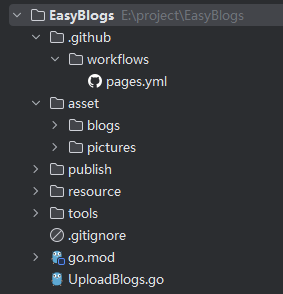
- .github:存放github action的配置文件
- asset:存放处理后的博客和图片,pictures起到了图床的作用
- publish:Hexo部署在此子目录
- resource:存放githubPub公钥
- tools:一些自己写的工具函数
- UploadBlogs:实现博客处理和自动push的脚本
1. 博客预处理
对md格式的博客进行预处理,使用正则表达式提取其中的图片路径:
- 对于本地图片,直接将其拷贝到asset/pictures目录中;
- 对于网络图片,将其下载在asset/pictures目录中。
在pictures目录中,对文章名和图片进行了哈希处理,如图:
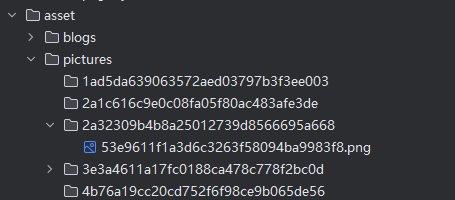
博客则直接按照原文件名放在blogs目录下。
博客中图片的链接会被替换为形如 https://raw.githubusercontent.com/buttering/EasyBlogs/master/asset/pictures/bdf03a9b9bdacaaf60d1f899c0222865/74d51bfa109b4065ccb3ba37b6922bb3.png的url。
raw.githubusercontent.com 是github用来存储用户上传文件的服务地址。
package main import ( "EasyBlogs/tools" "fmt" "github.com/go-git/go-git/v5" "github.com/go-git/go-git/v5/plumbing/object" "github.com/go-git/go-git/v5/plumbing/transport/ssh" "io" "log" "net/http" "net/url" "os" "path" "path/filepath" "regexp" "strings" "time" ) type markdownPicture struct { isUrl bool sourcePicturePath string start int // md中源图片路径的起始偏移量 end int hashName string // 均将包含后缀的文件名进行hash,且后拼接上原有后缀名 targetUrl string // 修改后在github仓库中的url } type Blog struct { name string hashName string pictures []markdownPicture directoryPath string // 源文件文件夹路径 legal bool // 成功通过解析 } var ( BLOG_PATH string PICTURE_PATH string REPOSITORY_URL string ) func getBlogList(path string) (blogsList []Blog) { blogsList = make([]Blog, 0, 10) fileList, err := os.ReadDir(path) if err != nil { panic(err) } for _, file := range fileList { if !file.IsDir() && filepath.Ext(file.Name()) == ".md" { fileName := file.Name() blogsList = append(blogsList, Blog{fileName, tools.Hash(fileName), nil, path, false}) } } return } func extractPicture(blog *Blog) { isUrl := func(path string) bool { return strings.HasPrefix(path, `http://`) || strings.HasPrefix(path, `https://`) } content, err := os.ReadFile(filepath.Join(blog.directoryPath, blog.name)) if err != nil { println(err) return } re, _ := regexp.Compile(`!\[.*?]\((.*?)\)`) matches := re.FindAllSubmatchIndex(content, -1) for _, match := range matches { start := match[2] end := match[3] picturePath := string(content[start:end]) var pictureName string if isUrl(picturePath) { u, err := url.Parse(picturePath) if err != nil { println("解析图片url:", picturePath, " 失败") continue } pictureName = path.Base(u.Path) } else if filepath.IsAbs(picturePath) { pictureName = filepath.Base(picturePath) } else { // 相对路径的本地文件 picturePath = filepath.Join(blog.directoryPath, picturePath) pictureName = filepath.Base(picturePath) } hashName := tools.Hash(pictureName) + path.Ext(pictureName) blog.pictures = append( blog.pictures, markdownPicture{ isUrl(picturePath), picturePath, start, end, hashName, REPOSITORY_URL + "/" + blog.hashName + "/" + hashName, }, ) } blog.legal = true } func copyBlog(blog *Blog) { fmt.Println("拷贝博客:“" + blog.name + "”") blogTargetPath := filepath.Join(BLOG_PATH, blog.name) pictureTargetPath := filepath.Join(PICTURE_PATH, blog.hashName) if _, err := os.Stat(blogTargetPath); !os.IsNotExist(err) { println("文章“" + blog.name + "”已经存在") blog.legal = false return } if err := os.Mkdir(pictureTargetPath, 0777); err != nil { println("为博客“" + blog.name + "”创建对应picture文件夹失败") blog.legal = false return } content, _ := os.ReadFile(filepath.Join(blog.directoryPath, blog.name)) offset := 0 for _, picture := range blog.pictures { start := picture.start + offset end := picture.end + offset content = append(content[:start], append([]byte(picture.targetUrl), content[end:]...)...) offset += len(picture.targetUrl) - (end - start) } err := os.WriteFile(blogTargetPath, content, 0644) if err != nil { println("复制文件“" + blog.name + "”错误") blog.legal = false } } func copyPicture(blog Blog) { pictureTargetPath := filepath.Join(PICTURE_PATH, blog.hashName) for _, picture := range blog.pictures { fmt.Println("导入图片:“" + picture.sourcePicturePath + "”") var sourceFile interface{} if picture.isUrl { for i := 0; i < 5; i++ { response, err := http.Get(picture.sourcePicturePath) if err == nil && response.StatusCode == http.StatusOK { sourceFile = response.Body break } time.Sleep(50 * time.Millisecond) } if sourceFile == nil { println("下载图片“" + picture.sourcePicturePath + "”失败") continue } } else { file, err := os.Open(picture.sourcePicturePath) if err != nil { println("打开图片“" + picture.sourcePicturePath + "”失败") continue } sourceFile = file } destinationFile, _ := os.Create(filepath.Join(pictureTargetPath, picture.hashName)) _, err := io.Copy(destinationFile, sourceFile.(io.Reader)) if err != nil { println("复制图片“" + picture.sourcePicturePath + "”失败") } } } func gitOperate(blogList []Blog) { if len(blogList) == 0 { return } repositoryPath, _ := filepath.Abs(".") r, err := git.PlainOpen(repositoryPath) if err != nil { println("打开仓库失败") return } w, err := r.Worktree() if err != nil { println("打开仓库失败") println(err.Error()) return } _, err = w.Add("./asset") if err != nil { println("向仓库添加文件失败") println(err.Error()) return } status, _ := w.Status() println("git 状态:") println(status.String()) nameList := tools.Map(blogList, func(blog Blog) string { return blog.name }) var summary string if len(nameList) == 1 { summary = fmt.Sprintf("提交文件 [%s]", blogList[0].name) } else { summary = fmt.Sprintf( "提交 %d 个博客\n"+ "\n"+ "文件列表: [%s]", len(blogList), strings.Join(nameList, ", "), ) } commit, err := w.Commit(summary, &git.CommitOptions{ Author: &object.Signature{ Name: "Wang", When: time.Now(), }, }) obj, _ := r.CommitObject(commit) fmt.Println("提交文件:") fmt.Println(obj.String()) // user必须是"git"。。。困扰了半天,最后查issue发现的。真够郁闷的。 privateKey, err := ssh.NewPublicKeysFromFile("git", "./resource/githubPublicKey", "") if err != nil { println(err.Error()) } for i := 0; i < 3; i++ { err = r.Push(&git.PushOptions{ RemoteName: "origin", RemoteURL: `git@github.com:buttering/EasyBlogs.git`, Auth: privateKey, Progress: os.Stdout, }) if err == nil { break } println("第 %d 次上传失败") } if err != nil { println("重试次数已达上限,上传失败") return } fmt.Println("提交成功!") } func init() { path, _ := filepath.Abs(".") BLOG_PATH = filepath.Join(path, "asset", "blogs") PICTURE_PATH = filepath.Join(path, "asset", "pictures") REPOSITORY_URL = `https://raw.githubusercontent.com/buttering/EasyBlogs/master/asset/pictures` } func main() { filePath := "E:/desktop/blog" //yamlPath := "./asset/blogs-list.yaml" blogList := getBlogList(filePath) for i := range blogList { extractPicture(&blogList[i]) copyBlog(&blogList[i]) copyPicture(blogList[i]) } if len(blogList) == 0 { return } // 改用github page进行博客部署,不需要额外记录博客信息 //yamlOperate(yamlPath, blogList) //dbOperate(blogList) gitOperate(blogList) }
- 1
- 2
- 3
- 4
- 5
- 6
- 7
- 8
- 9
- 10
- 11
- 12
- 13
- 14
- 15
- 16
- 17
- 18
- 19
- 20
- 21
- 22
- 23
- 24
- 25
- 26
- 27
- 28
- 29
- 30
- 31
- 32
- 33
- 34
- 35
- 36
- 37
- 38
- 39
- 40
- 41
- 42
- 43
- 44
- 45
- 46
- 47
- 48
- 49
- 50
- 51
- 52
- 53
- 54
- 55
- 56
- 57
- 58
- 59
- 60
- 61
- 62
- 63
- 64
- 65
- 66
- 67
- 68
- 69
- 70
- 71
- 72
- 73
- 74
- 75
- 76
- 77
- 78
- 79
- 80
- 81
- 82
- 83
- 84
- 85
- 86
- 87
- 88
- 89
- 90
- 91
- 92
- 93
- 94
- 95
- 96
- 97
- 98
- 99
- 100
- 101
- 102
- 103
- 104
- 105
- 106
- 107
- 108
- 109
- 110
- 111
- 112
- 113
- 114
- 115
- 116
- 117
- 118
- 119
- 120
- 121
- 122
- 123
- 124
- 125
- 126
- 127
- 128
- 129
- 130
- 131
- 132
- 133
- 134
- 135
- 136
- 137
- 138
- 139
- 140
- 141
- 142
- 143
- 144
- 145
- 146
- 147
- 148
- 149
- 150
- 151
- 152
- 153
- 154
- 155
- 156
- 157
- 158
- 159
- 160
- 161
- 162
- 163
- 164
- 165
- 166
- 167
- 168
- 169
- 170
- 171
- 172
- 173
- 174
- 175
- 176
- 177
- 178
- 179
- 180
- 181
- 182
- 183
- 184
- 185
- 186
- 187
- 188
- 189
- 190
- 191
- 192
- 193
- 194
- 195
- 196
- 197
- 198
- 199
- 200
- 201
- 202
- 203
- 204
- 205
- 206
- 207
- 208
- 209
- 210
- 211
- 212
- 213
- 214
- 215
- 216
- 217
- 218
- 219
- 220
- 221
- 222
- 223
- 224
- 225
- 226
- 227
- 228
- 229
- 230
- 231
- 232
- 233
- 234
- 235
- 236
- 237
- 238
- 239
- 240
- 241
- 242
- 243
- 244
- 245
- 246
- 247
- 248
- 249
- 250
- 251
- 252
- 253
- 254
- 255
- 256
- 257
- 258
- 259
- 260
- 261
- 262
- 263
- 264
- 265
- 266
- 267
- 268
- 269
- 270
- 271
- 272
- 273
- 274
- 275
- 276
- 277
- 278
- 279
- 280
- 281
- 282
- 283
- 284
- 285
- 286
- 287
- 288
- 289
- 290
- 291
- 292
2. 引入Hexo框架
Hexo框架的使用方式很简单,只需使用Hexo CLI建立基本框架,而后将博客和相关资源移入指定文件夹,然后运行Hexo服务器即可。这里为实现Serverless,后两部交由github action实现。
安装Hexo并初始化站点
保证电脑中安装了Node.js。Hexo的部署目录为publish。
npm install -g hexo-cli
nexo init publish
cd publish
npm install
- 1
- 2
- 3
- 4
执行后,Hexo会自动在publish目录建立一个空白站点,目录如下:
.
├── _config.yml
├── package.json
├── scaffolds
├── source
| └── _posts
└── themes
- 1
- 2
- 3
- 4
- 5
- 6
- 7
- _config.yml:站点的配置文件
- _posts:Hexo会自动将其中的文档转化为静态资源
- themes:主题文件夹
安装fluid主题
初始的Hexo站点已经很完善了,但是为了更加个性化,安装了fluid主题:配置指南 | Hexo Fluid 用户手册 (fluid-dev.com)
# 仍是在publish目录
npm install --save hexo-theme-fluid
- 1
- 2
然后在博客目录下创建 _config.fluid.yml,将主题的 _config.yml(位于publish\themes\fluid_config.yml)内容复制进去。这个_config.fluid.yml是主题的覆盖配置,之后要自定义主题,只需修改其中的内容即可。
修改publish下的_config.yml如下:
theme: fluid # 指定主题
language: zh-CN # 指定语言,会影响主题显示的语言,按需修改
- 1
- 2
最后创建主题的关于页
hexo new page about
- 1
测试博客
自此,一个本地的博客网站即搭建成功,可以尝试手动将文档移入_post文件夹,而后在命令行内的 publish 文件夹下运行 hexo g 和 hexo s ,就可以在浏览器看到博客。
最后记得使用hexo clean 清空生成的文件,避免影响到后面的部署。
3. github actions配置
在预处理函数的最后一步,实现了git的自动提交和推送。在成功向github推送后,就轮到github action实现博客网站的自动部署了。
配置github仓库
首先将本地的git仓库上传至github,且设置为公开。
进入github 项目的设置页面开启page功能。设置Source为GitHub Actions。
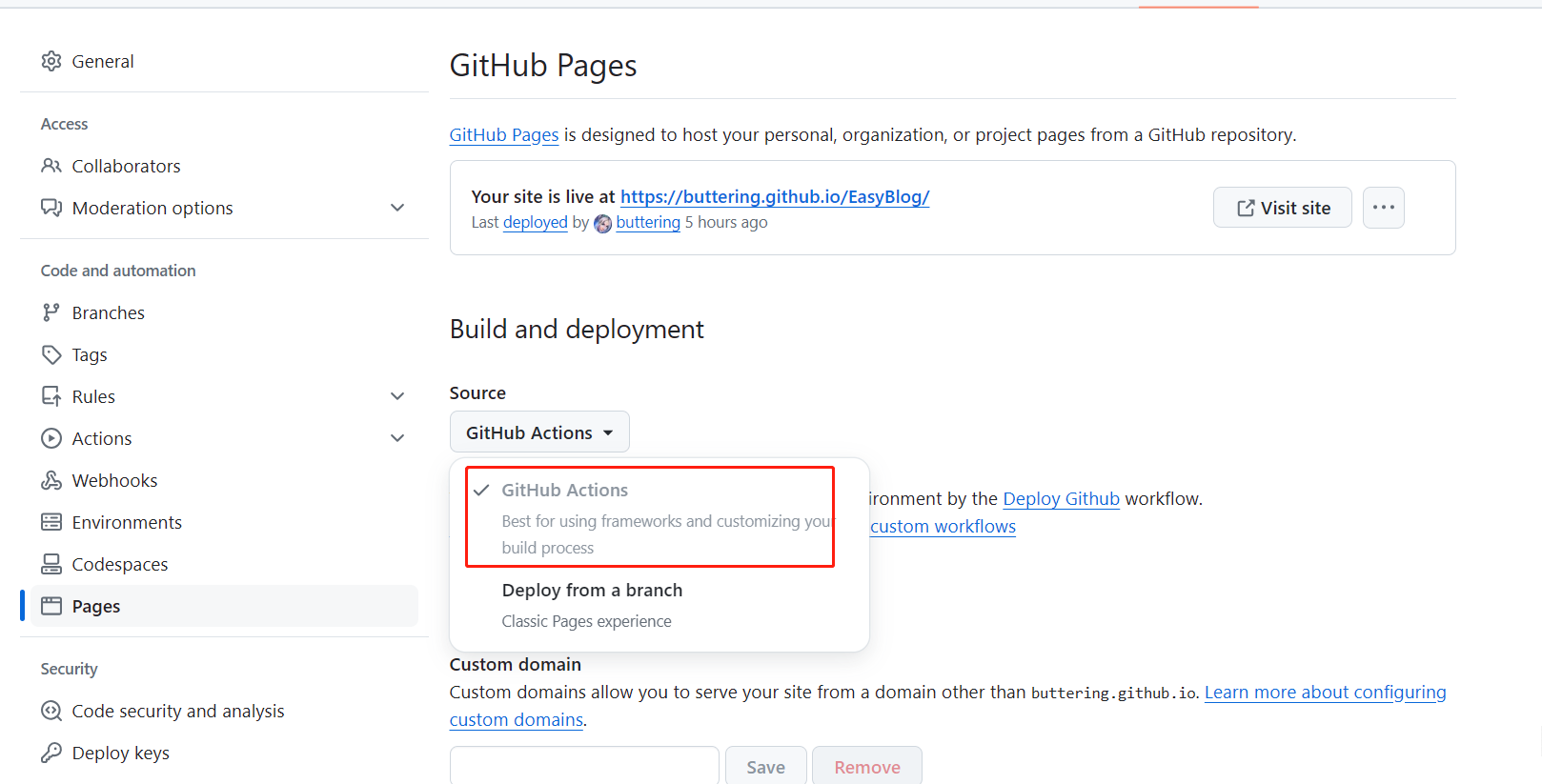
编写actions脚本文件
回到本地,在项目根目录创建 .github/workflows/xxx.yml 文件。
这里需要一些github actions的知识,简单地说 Actions 就是在设定的时机触发创建一个虚拟云环境,然后执行一连串动作,从而实现自动部署的功能。
可以直接复制以下内容:
name: Deploy Github # 在master分支发生push事件时触发。 on: push: branches: - master workflow_dispatch: jobs: build: runs-on: ubuntu-latest steps: - name: 检出仓库 uses: actions/checkout@v4 - name: Install pandoc run: | cd /tmp wget -c https://github.com/jgm/pandoc/releases/download/2.14.0.3/pandoc-2.14.0.3-1-amd64.deb sudo dpkg -i pandoc-2.14.0.3-1-amd64.deb - name: 安装Node.js 18 uses: actions/setup-node@v4 with: node-version: '18' - name: Cache NPM dependencies uses: actions/cache@v4 with: path: node_modules key: ${{ runner.OS }}-npm-cache restore-keys: | ${{ runner.OS }}-npm-cache - name: 安装相关依赖 working-directory: publish run: | npm install --silent --no-fund npm un hexo-renderer-marked --save npm i hexo-renderer-markdown-it-plus --save - name: 复制博客文件 run: | cd publish rm -rf source/_posts mkdir source/_posts cp -rf ../asset/blogs/* ./source/_posts/ - name: 构建网站 working-directory: publish run: npm run build - name: Upload Pages artifact uses: actions/upload-pages-artifact@v3 with: path: ./publish/public deploy: needs: build permissions: pages: write id-token: write environment: name: github-pages url: ${{ steps.deployment.outputs.page_url }} runs-on: ubuntu-latest steps: - name: Deploy to GitHub Pages id: deployment uses: actions/deploy-pages@v4
- 1
- 2
- 3
- 4
- 5
- 6
- 7
- 8
- 9
- 10
- 11
- 12
- 13
- 14
- 15
- 16
- 17
- 18
- 19
- 20
- 21
- 22
- 23
- 24
- 25
- 26
- 27
- 28
- 29
- 30
- 31
- 32
- 33
- 34
- 35
- 36
- 37
- 38
- 39
- 40
- 41
- 42
- 43
- 44
- 45
- 46
- 47
- 48
- 49
- 50
- 51
- 52
- 53
- 54
- 55
- 56
- 57
- 58
- 59
- 60
- 61
- 62
- 63
- 64
- 65
- 66
- 67
- 68
- 69
- 70
- 71
github 工作流在完成了环境的初始化后,会自动将位于 asset/blog 中的博客文件复制到 publish/source/_post 目录内。而后的构建步骤,工作流就会利用 _post 目录中的博客文件生成网站。
修改配置
编辑 _config.yml,将 url: 更改为 <你的 GitHub 用户名>.github.io/<repository 的名字>。
提交并自动部署
在提交前,记得编辑.gitignore文件:
/resource/githubPublicKey
/publish/node_modules/
/publish/public/
- 1
- 2
- 3
在之后的每次提交,都会触发actions流程,生成站点。部署完成后,前往 https://<你的 GitHub 用户名>.github.io/<repository 的名字> 查看站点。
4. 开启latex功能
hexo默认的渲染器不支持复杂的数学公式。
Latex的渲染分为前端渲染和后端渲染两种方法,这里选择后端渲染,需要更换渲染器(已经在actions脚本中完成了)。
npm un hexo-renderer-marked --save
npm i hexo-renderer-markdown-it-plus --save
- 1
- 2
修改 _config.fluid.yml:
post:
math:
enable: true
specific: false
engine: katex
- 1
- 2
- 3
- 4
- 5
使用hexo-renderer-markdown-it-plus插件进行latex渲染时,如果使用mathjax,一些不完全符合md语法的标题会渲染失败(如一级标题前没有空行),因此要将引擎改为katex。
可以参考配置指南 | Hexo Fluid 用户手册 (fluid-dev.com) 和 CHENXCHEN/hexo-renderer-markdown-it-plus
5. 实现评论功能
使用 Giscus插件,且基于 GitHub Discussion实现评论功能。
开启 GitHub Discussion
进入github仓库->Settings->General->Features,勾选 Discussions。

安装 Github Apps
点击链接GitHub Apps - giscus ,为本仓库安装应用。
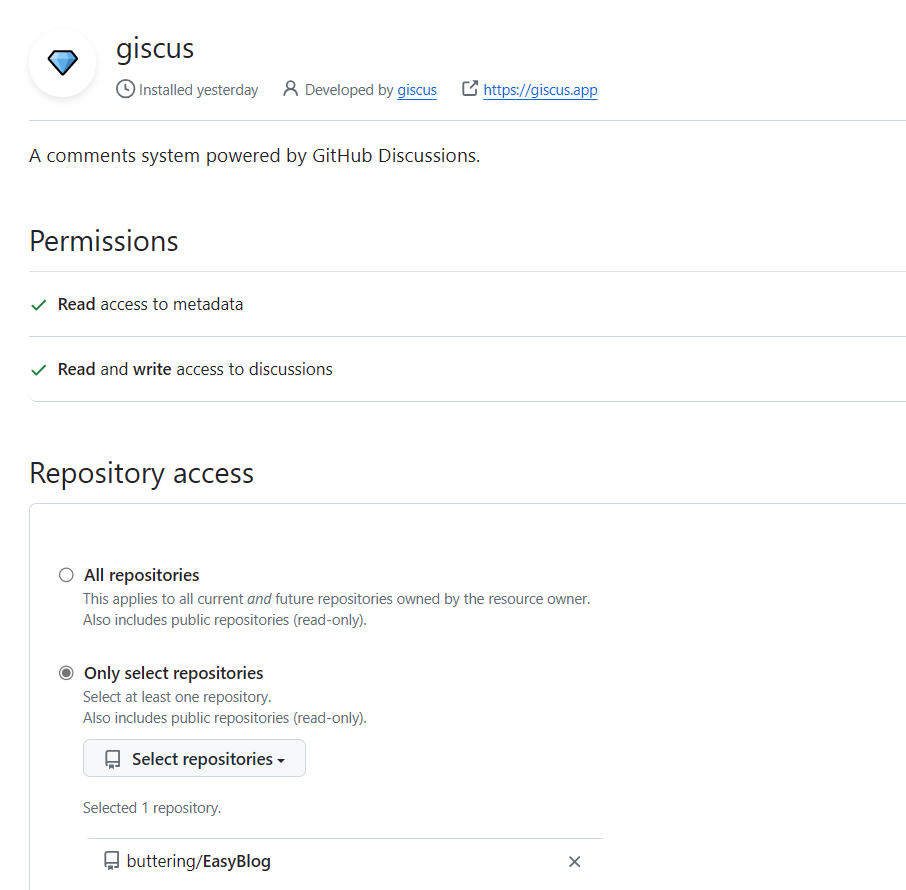
可以到 giscus仓库 检查自己的仓库是否满足giscus要求的条件。
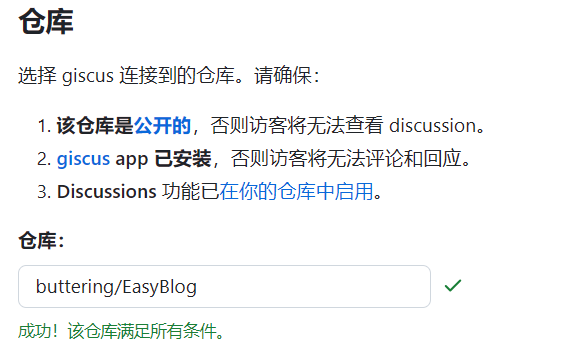
配置插件
由于使用了fluid主题,因此只需修改配置文件即可开启评论。
修改 _config.fluid.yml:
comments: enable: true # 指定的插件,需要同时设置对应插件的必要参数 # The specified plugin needs to set the necessary parameters at the same time # Options: utterances | disqus | gitalk | valine | waline | changyan | livere | remark42 | twikoo | cusdis | giscus | discuss type: giscus # Giscus # 基于 GitHub Discussions,类似于 Utterances # Based on GitHub Discussions, similar to Utterances # See: https://giscus.app/ giscus: repo: buttering/EasyBlog repo-id: category: Announcements category-id: theme-light: light theme-dark: dark mapping: title reactions-enabled: 1 emit-metadata: 0 input-position: bottom lang: zh-CN
- 1
- 2
- 3
- 4
- 5
- 6
- 7
- 8
- 9
- 10
- 11
- 12
- 13
- 14
- 15
- 16
- 17
- 18
- 19
- 20
- 21
- 22
- 23
在配置基于 Github Discussions 的博客评论系统时(例如 giscus),往往需要获取 repo 的 repo-id, category-id 等属性,因此这里介绍一种获取这些信息的方法
首先打开以下 Github Docs 地址:Github Docs Explorer,然后授权 Github 账户,并输入以下内容
{
repository(owner: "userName", name: "repoName") {
id
discussionCategories (first: 5) {
nodes {
name
id
}
}
}
}
- 1
- 2
- 3
- 4
- 5
- 6
- 7
- 8
- 9
- 10
- 11
- 将
userName换成具体的 Github 用户名; - 将
repoName换成保存评论数据的 Repo 名称。
点击运行按钮,即可得到形如 "id": "R_kgDOKjFfn1" 和 DIC_kwdOJPFfnc4CU9... 就是我们需要的 repoId 和 categoryId。
因为网站中文章的url是直接使用文章名进行定位的,如 https://buttering.github.io/EasyBlog/2022/10/15/使用plotly离线模式报错UnicodeEncodeError:gbk codec can't encode character in position的解决方法/,如果 mapping: 的值设为 pathname 或者 url,其在 github discussions中出现的标题,中文会被base64字符代替,严重影响观感,设为 title 可以解决这个问题。
6. 实现访问统计
参考Hexo-fluid主题设置统计博客阅读量与评论 - 贾明晖的博客 (minghuijia.cn)
到LeanCloud注册一个免费账户,创建一个开发板应用后,再创建一个Class(依次点击数据存储->结构化存储->创建Class),权限给到最大。
然后在设置->应用凭证里找到AppID与AppKey。
修改 _config.fluid.yml:
# 网页访问统计 # Analysis of website visitors web_analytics: # 网页访问统计 enable: true # LeanCloud 计数统计,可用于 PV UV 展示,如果 `web_analytics: enable` 没有开启,PV UV 展示只会查询不会增加 leancloud: app_id: xxx app_key: xxx # REST API 服务器地址,国际版不填 server_url: # 统计页面时获取路径的属性 path: window.location.pathname # 开启后不统计本地路径( localhost 与 127.0.0.1 ) ignore_local: false footer: # 展示网站的 PV、UV 统计数 statistics: enable: true
- 1
- 2
- 3
- 4
- 5
- 6
- 7
- 8
- 9
- 10
- 11
- 12
- 13
- 14
- 15
- 16
- 17
- 18
- 19
7. 网站运行时长
参考Fluid 页脚增加网站运行时长 - Hexo Theme Fluid (fluid-dev.com)
修改 _config.fluid.yml:
footer:
content: '
<a href="https://hexo.io" target="_blank" rel="nofollow noopener"><span>Hexo</span></a>
<i class="iconfont icon-love"></i>
<a href="https://github.com/fluid-dev/hexo-theme-fluid" target="_blank" rel="nofollow noopener"><span>Fluid</span></a>
<div style="font-size: 0.85rem">
<span id="timeDate">载入天数...</span>
<span id="times">载入时分秒...</span>
<script src="/js/duration.js"></script>
</div>
'
- 1
- 2
- 3
- 4
- 5
- 6
- 7
- 8
- 9
- 10
- 11
content 前三行是 Fluid 原有的页脚内容,建议不要删除,可稍作修改,保留 Fluid 的超链接,用于向更多人推广主题。
新增的div标签用于实现功能。duration.js 包含的是功能代码,我们在博客目录的 source/js 下创建 duration.js (如果没有js目录,创建即可),
如果直接创建source/js/duration.js 是无效的
针对fluid 1.9.7: 需要将 content 的 <script src="/js/duration.js"> 这行改为 <script src="<项目根目录名>/js/duration.js">,如 <script src="/EasyBlog/js/duration.js"></script>
js文件内容如下:
!(function() { /** 计时起始时间,自行修改 **/ var start = new Date("2020/01/01 00:00:00"); function update() { var now = new Date(); now.setTime(now.getTime()+250); days = (now - start) / 1000 / 60 / 60 / 24; dnum = Math.floor(days); hours = (now - start) / 1000 / 60 / 60 - (24 * dnum); hnum = Math.floor(hours); if(String(hnum).length === 1 ){ hnum = "0" + hnum; } minutes = (now - start) / 1000 /60 - (24 * 60 * dnum) - (60 * hnum); mnum = Math.floor(minutes); if(String(mnum).length === 1 ){ mnum = "0" + mnum; } seconds = (now - start) / 1000 - (24 * 60 * 60 * dnum) - (60 * 60 * hnum) - (60 * mnum); snum = Math.round(seconds); if(String(snum).length === 1 ){ snum = "0" + snum; } document.getElementById("timeDate").innerHTML = "本站安全运行 "+dnum+" 天"; document.getElementById("times").innerHTML = hnum + " 小时 " + mnum + " 分 " + snum + " 秒"; } update(); setInterval(update, 1000); })();
- 1
- 2
- 3
- 4
- 5
- 6
- 7
- 8
- 9
- 10
- 11
- 12
- 13
- 14
- 15
- 16
- 17
- 18
- 19
- 20
- 21
- 22
- 23
- 24
- 25
- 26
- 27
- 28
- 29
- 30
- 31
把 start 的时间改为自己的时间即可。



